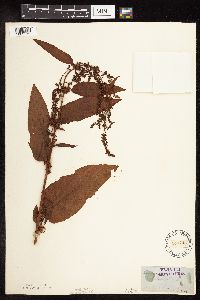Rumex obtusifolius
|
|
|
|
Family: Polygonaceae
Bitter Dock, more...bluntleaf dock (es: lengua de vaca)
[Acetosa oblongifolia (L.) A.& D. Löve, moreRumex obtusifolius subsp. agrestis (Fries) Danser, Rumex obtusifolius subsp. sylvestris (Wallr.) Rech. f., Rumex obtusifolius var. obtusifolius L., Rumex obtusifolius var. sylvestris (Wallr.) Koch] |
Plants perennial, glabrous or ± papillose especially on veins of leaf blades abaxially, with fusi-form, vertical rootstock. Stems erect, branched distal to middle or occasionally in distal 2/ 3, often with few flowering stems from rootstock, 60-120(-150) cm. Leaves: ocrea deciduous to partially persistent at maturity; blade oblong to ovate-oblong, sometimes broadly ovate, 20-40 × 10-15 cm, usually less than 4 times as long as wide, base normally distinctly cordate, occasionally rounded, rarely truncate, margins normally entire, flat or undulate, rarely slightly crisped, apex obtuse or subacute. Inflorescences terminal, occupying distal 2/ 3 of stem, usually lax and interrupted, narrowly or broadly paniculate, branches usually forming angle of 30-45° with 1st-order stem. Pedicels articulated in proximal 1/3 or rarely near middle, filiform, 2.5-8.5(-10) mm, articulation distinctly swollen. Flowers 10-25 in lax whorls; inner tepals ovate-triangular, deltoid or, occasionally, lingulate, 3-6 × 2-3.5 mm (excluding teeth), ca. 1.5-2 times as long as wide, base truncate, margins usually distinctly dentate, rarely subentire, apex obtuse to subacute, straight, teeth 2-5, normally at each side of margin, short-subulate or triangular-subulate, straight, 0.5-1.8 mm, or shorter than width of inner tepals; tubercle usually 1, sometimes 3, then 1 distinctly larger, smooth. Achenes brown to reddish brown, 2-2.7 × 1.2-1.7 mm. 2n = 40. Flowering late spring-early fall. Waste places, roadsides, fields, shores, meadows, wet woods, swamps; 0-2300 m; introduced; Greenland; St. Pierre and Miquelon; B.C., N.B., Nfld. and Labr. (Nfld.), N.S., Ont., P.E.I., Que.; Ala., Alaska, Ariz., Ark., Calif., Colo., Conn., Del., D.C., Fla., Ga., Idaho, Ill., Ind., Iowa, Kans., Ky., La., Maine, Md., Mass., Mich., Minn., Miss., Mo., Mont., Nebr., N.H., N.J., N.Mex., N.Y., N.C., Ohio, Okla., Oreg., Pa., R.I., S.C., Tenn., Tex., Utah, Vt., Va., Wash., W.Va., Wis.; Europe; w Asia; introduced elsewhere. Rumex obtusifolius, a member of subsect. Obtusifolii Rechinger f. (K. H. Rechinger 1937), is a polymorphic species represented in Eurasia by three or four rather distinct races often treated by European authors as subspecies or varieties. These taxa differ mostly in inner tepal dentation and geographic distribution. In North America the morphotypes often intergrade. In Eurasia this species is differentiated into predominantly western subsp. obtusifolius [including R. obtusifolius subsp. agrestis (Fries) Danser], eastern subsp. sylvestris (Wallroth) Rechinger f., intermediate central European subsp. transiens (Simonkai) Rechinger f., and montane subsp. subalpinus (Schur) Simonkai. Only subspp. obtusifolius and sylvestris occur in North America; the former seems to be more common. Subspecies obtusifolius differs from subsp. sylvestris in having larger and more prominently dentate inner tepals with one tubercle, or with three distinctly unequal tubercles; in subsp. sylvestris the teeth are usually less than 0.6 mm, developing only near the base of the inner tepals, and the tubercles often almost subequal. Rumex obtusifolius may be expected elsewhere in the Great Plains region of the United States and Canada.
Stout perennial to 12 dm from a large tap or branched root, usually single-stemmed and simple to the infl; lower lvs cordate at base, broadly oblong to ovate, to 15 cm wide, the upper much smaller; infl freely branched, the lower verticils commonly separate and leafy-bracted; pedicels conspicuously longer than the fr, jointed below the middle; valves triangular-ovate, 3.5-5 mm, with 2-4 spinose teeth on each margin, one bearing a large, minutely wrinkled grain, the others merely with a slightly thickened midrib; 2n=50. Native of Europe, commonly naturalized in waste ground, especially in moist soil, from Que. and N.S. to B.C., s. to Fla. and Ariz. Gleason, Henry A. & Cronquist, Arthur J. 1991. Manual of vascular plants of northeastern United States and adjacent Canada. lxxv + 910 pp. ©The New York Botanical Garden. All rights reserved. Used by permission. From Flora of Indiana (1940) by Charles C. Deam Infrequent to frequent throughout the state. It is found almost everywhere in moist or rather moist soil in open woodland, fallow fields, and wasteland and along roadsides. The veins of the leaves of this species are sometimes red and I think our reports for Rumex sanguineus should be referred to this species. …… Indiana Coefficient of Conservatism: C = null, non-native Wetland Indicator Status: FACW |
|
|
|










































































